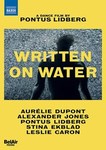|
Back
07/07/2021
Written on Water
Pontus Lidberg (writer, director, choreographer), Stefan Levin (music), Magnus Svensson (piano), Aurélie Dupont (Alicia), Alexander Jones (Giovanni), Pontus Lidberg (Karl), Stina Ekblad (Rachel), Sarawanee Tanatanit (Sara), Leslie Caron (Pauline), Valerie Valera (set designer), Michelle Kane (costume designer), Martin Nisser (director of photography)
Recording: Germany (2020) – 78’
A BelAir Media Production in collaboration with ZDF / ARTE and Adb
Naxos Classics 2.110688 (or Blu-ray NBD0128V) – PCM Stereo and DTS 5.1 – NTSC 16:9 – Region: 0 – DVD 9 (Distributed by Naxos of America) – Booklet in English – Subtitles in French, English, German, Japanese and Korean

   
Swedish choreographer Pontus Lidberg didn’t want to make a dance drama, and thankfully he avoided some typical scenarios about tyrannical choreographers or obsessive ballerinas. So, conceptually anyway, his dive into experimental structure is admirable, but story-wise, perhaps true to its title, Written on Water, just released by Naxos on DVD/Blu-ray, is a completely adrift dance film.
In the Naxos booklet, Lidberg writes that with this film he seeks to go beyond “...The permeable boundaries between the dance and the drama around it, highlight a core idea of the film: that our subjective perceptions and personal interpretations become our reality.”
Lidberg is the recipient of a Guggenheim Fellowship, has his own concert dance company and is an in-demand and accomplished dancemaker with commissions with Swedish Ballet, Paris Opera Ballet, New York City Ballet, the Martha Graham Company, among others.
On the upside, Written on Water has a compelling score by Stefan Levin and the cinematography by Martin Nisser, beautiful atmospherics of street scenes, interiors and seascapes. They hold focus more than Lidberg’s scenario about a choreographer creating a new ballet in the midst of having a complicated love affair. There is an adage in dance-theater that says what you cannot tell in words, you can express in dance. But evocative concepts on the dance stage, do not always translate the way in cinematic language.
The story opens as Alicia, a director-choreographer creating a new ballet on 16 dancers. Former Paris Opera Ballet star Aurélie Dupont portrays Alicia with an earnest intensity that reveals little. Meanwhile, there are languorous sections of her rehearsal process with just snatches of dialogue about the creative process. The legendary star Leslie Caron (as dance doyenne Pauline) even appears briefly, lending her guidance to Alicia, but she is scripted with colorless lines that are barely audible.
Meanwhile, Alicia gives notes to the dancers, but mostly she becomes preoccupied by a new young dancer named Giovanni, who is played by Zurich Ballet principal dancer Alexander Jones. Alicia tries to be casual, but is soon so obsessed to the point that she intimates “I could smell him in the empty corridors” and a few other cringe-worthy bits of dialogue. This narrative foreplay stays static until Alicia suddenly is explaining her feelings to Karl (played by director Lidberg) who is also a dancer in the troupe, but it is unclear what his relationship with Alicia is. But it is unclear when they are writing a fictional story or living it.
Soon enough it is back to Alicia agonizing private thoughts about flirting with Giovanni, their age difference and the fact that she is his boss. They give each other mixed signals with chaste walks on a foggy pier, and showing each other dance moves and having coffee. When it gets too real Giovanni pulls back, and Alicia tells him “It wasn’t casual you know…I wasn’t looking for an adventure.” Suddenly it is revealed that Karl is having an affair with Giovanni, and they are shown doing more than having coffee. Is Giovanni an avatar from their actual past, or is art imitating their lives turned into an abstract ballet, or as Karl explains it at one point, the story of a mythic Greek sea tale of Ulysses and the sirens?
Giovanni, for one, isn’t sticking around for either explanation and announces that he is leaving for New York. At the ballet’s premiere Pauline gives Karl sage advice backstage “Something like that can’t last forever.” While this sweaty melodrama is lost in the sea mist, the 16 dancers remain stranded in choreographic purgatory marking the same mechanical steps. There are only glimpses for full dance scenes from the ballet that Alicia is creating, so, by extension, a missed opportunity to see more of Lidberg’s choreography onscreen.
Lewis J. Whittington
|